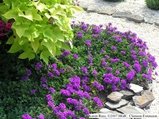|
Ozark Green Thumb BCMG Monthly e-Newsletter |
|
|
 Verbenas are long blooming annual or perennial flowers that possess the virtues of heat tolerance and an extremely long bloom season. Many perennial verbenas are relatively short lived, but their vigor and heavy flowering make up for this defect. They do well grown as annual flowering plants also, since they bloom quickly during the first season after planting. Height/Spread
Verbenas vary considerably in size. The ground skimming moss verbena and trailing verbena reach 1 foot or less in height and spread from 2 to 5 feet wide. Verbena rigida usually grows 1 to 1½ feet tall, while purpletop vervain and the native blue verbena can reach 4 to 5 feet tall, but only a foot or two in width. Growth Rate Verbenas generally grow moderately to quickly, and unlike many perennials, bloom well the first season after planting. Some varieties, such as 'Homestead Purple', are extremely vigorous. If plants outgrow their assigned space, they tolerate trimming back well. Ornamental Features Verbenas are mainly grown for their remarkable length of bloom with most blooming from spring until close to frost if trimmed back once or twice in mid summer. Flower color ranges from white through pink, red, lavender, blue and purple. Landscape Use Verbenas require a location that receives full sun throughout the day. They must have well-drained soil. They will not tolerate overcrowding with poor air circulation, shade or soil that stays overly moist. Most problems of verbenas occur in improper growing conditions. Verbenas are best planted in the spring or summer. Pinch the tips of the branches at planting time to encourage dense branching and a fuller plant. Newly planted verbenas will need to be kept moist for the first few weeks until the roots have spread into the surrounding soil. While established verbenas are drought tolerant, performance, bloom, and growth rate will be reduced if they are too dry for a long period. During their blooming period, give them a thorough watering once a week if they do not receive an inch of rain that week. Avoid overhead watering. If bloom slows during the summer, trim the whole plant back by about one fourth of its height and spread, water thoroughly and fertilize lightly. The plant will return to bloom within 2 to 3 weeks. A light application of a complete fertilizer such as 16-4-8 in mid- to late spring and again after trimming back will revitalize plants, but additional fertilization is not generally required. Plants growing in very sandy, poor soil may need more frequent fertilization. In the fall you can trim back verbenas lightly to give a neater appearance to the garden, but do not cut severely until spring as new growth begins to appear. Overly severe fall pruning can reduce cold hardiness and plants may not survive a cold winter. Most verbenas are short-lived, so you should plan on replacing them after two or three years. However, some species can re-seed and naturalize in the garden. Verbenas, especially the trailing and moss types, grow very well in containers. Fertilize container grown plants either with a controlled-release fertilizer, or with a liquid fertilizer once a month. Container grown plants should be watered more frequently, and not allowed to dry out. All verbena will attract numerous butterfly species, bumblebees, and hummingbirds. Problems Verbenas can suffer from a variety of problems, but most occur when they are grown in low light, poorly drained soil, or when the soil stays excessively moist from excessive watering. Poor air circulation from over crowded conditions can also lead to disease problems.
Verbenas are relatively pest free
Cultivars & Species Tall growing Purpletop vervain (Verbena bonariensis)
Trailing Verbena (Glandularia canadensis; formerly Verbena canadensis) Trailing verbena is a native perennial throughout South Carolina. The plants have a low spreading form and will flower profusely all summer. Creeping stems often root into the soil or mulch. Plants are tolerant of heat and drought, although best growth will occur with plenty of water and fertilizer. Like most verbenas, they need excellent soil drainage. There are numerous cultivars available. Many are trailing verbenas are hybrids of G. canadensis with other species.
Rigid Verbena (Verbena rigida) This South American verbena forms spreading patches of brilliant purple. It is widely naturalized along roadsides throughout South Carolina. It spreads by long white rhizomes (underground stems) which spread out in all directions and form dense colonies. Because of this growth habit, it forms a very effective ground cover. Rigid Verbena is hardy and drought resistant.
(Glandularia pulchella; formerly Verbena tenuisecta) Native to South America, but naturalized throughout the southern United States, moss verbena is so well adapted as to be commonly believed to be native. It is generally hardy in the lower parts of South Carolina, and often survives mild winters in the Upstate. Moss verbena has finely cut leaves and a very low growing habit, explaining its common name. Many of the cultivars are hybrids with other species.
(Glandularia x hybrida; formerly Verbena x hybrida) Annual verbena is a relatively common garden bedding plant. Most varieties will decline once summer heat increases. Perennial type verbenas will perform better in South Carolina, and will bloom quickly the first season of planting. Source: Clemson University Cooperative University
1 Comment
philip kirk
5/2/2022 12:41:07 pm
Great article, thanks! They aren't native, are they? But still, everyone loves them. I have a newly dozed bottomfield with lots of them. I'm glad that the enviro native purists haven't tried to create a taxpayer funded program to eradicate them because they're not from here.
Reply
Leave a Reply. |
Archives
April 2022
|
|
